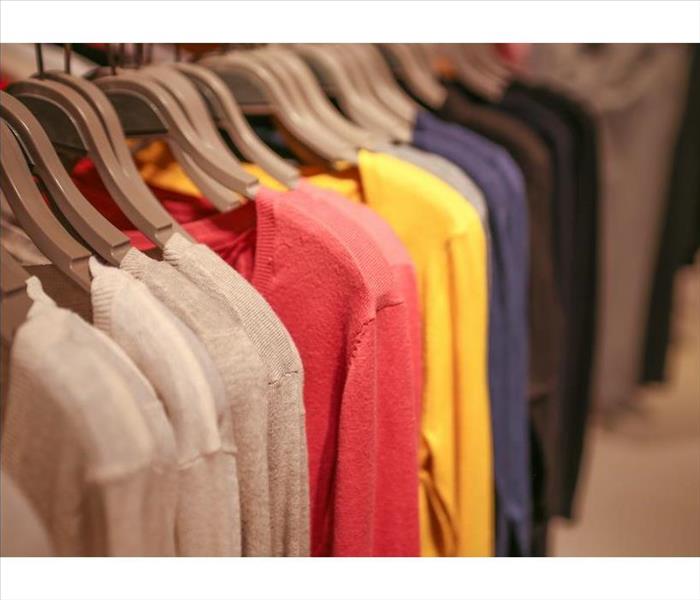What Is The Most Reliable Way To Manage Moisture During Water Damage Restoration In San Leandro Clothes Shops?
7/7/2020 (Permalink)
 You can depend on our technicians to respond quickly to clean up and restore your shop so you can get back to business as usual.
You can depend on our technicians to respond quickly to clean up and restore your shop so you can get back to business as usual.
Moisture Control Is a Complex Issue, but SERVPRO Has Sufficient Resources to Help Tackle It Restoring Your Store to Its Pre-Loss Condition
If a pipe burst or other form of water intrusion happens at your San Leandro cloth store, you have much to worry about since moisture can cause widespread damages to the structure and contents. Clothes and other items in your stock can readily absorb and hold water if exposed. Packing materials such as boxes have hygroscopic properties so they can absorb moisture from the air.
What moisture problems does water damage restoration need to address in San Leandro Stores?
- Physical deterioration such as the disintegration of packing
- Staining of clothes or upholstery and carpets
- Strong odors
- Mold infestation
Once the water is released into the store, various forms of deterioration begin happening. Some may have immediate implications, while others can affect the business for a long time. Removing all standing water from the property and drying most of the affected items or materials in the property within 48 hours ensures you can salvage more items and prevents long-term problems such as mold development. Our SERVPRO technicians can also help with odor control processes such as removal of odorous materials and deodorization of the entire property eliminating traces of the incident, "Like it never even happened.”
What moisture control steps are necessary when restoring water damage?
- Drying your wet stock
- Dealing with humidity
- Extracting standing water
- Preventing condensation and other moisture transfer
The main problem with water damage incidents is the excessive moisture introduced to the indoor environment. Finding a way to restore normalcy, therefore, helps stop or reverse any problems that develop. In most cases, you can stop the water source by turning off the mains immediately you discover the loss. Our SERVPRO technicians complement your efforts by expediting the extraction of standing water from the display areas, storage, or other sections of the store.
We have various types of equipment to support faster extraction. For example, we have portable water extractors with an auto-fill and auto-dump feature for continuous operation. We also have weighted extractors useful for carpeted areas within the store.
Another problem is moisture transfer, which can damage materials unaffected by the initial water spill. For instance, when the water spill originates from the floor level, it is less likely to affect the clothes on hanging displays or shelves. However, the rising humidity levels in the store can lead to moisture transfer affecting those items. Another challenge arises since transferring the items away from the store is likely to take time and require additional storage resources. Our technicians take steps such as running a dehumidifier or two when we start restoration to control humidity.
Do odors develop whenever there is a water spill?
An odor problem in a cloth store can be a disaster since it can dissuade people from buying the items you sell. Smells develop for several reasons, so there is a high chance that your store could develop an unpleasant odor after a water spill. The common ones include:
- A higher concentration of sulfate in the spilled water
- Microbial growth processes
- Dissolving of soils in the areas water reaches
Our crews take several steps at different stages of the restoration to ensure we remove all odors from your property. When cleaning surfaces, we use products such as synthetic phenolics, which have antimicrobial and odor counteracting properties, thus stopping odors at the source.
Microbial growth, such as mold development, tends to thrive when pockets of moisture remain in hidden areas. Our technicians inspect the store to find out whether moisture remains in the wall, ceiling, or floor cavities. We use thermal cameras for non-invasive inspection. We also check whether solid wood, concrete and other porous materials with moisture meters to ensure they dry properly. In case we find hidden moisture, we perform controlled demolition to reach the wet materials. In most cases, water finds a way into wall cavities through the porous drywall or openings, then internal components such as insulation act as a moisture reservoir. With the controlled demolition, we can remove the outer coverings such as the drywall to reach the wet materials and to circulate dry air within the wall assembly.
The upholstery items in areas such as the fitting room or waiting area can also retain moisture leading to mold development and other problems that create an unpleasant odor. Our SERVPRO technicians help perform the elaborate drying procedures needed to dry such items forestalling the problems. We confirm the level of wetness with penetrative moisture meters before taking restorative steps. If the items only absorbed minimal amounts of water, we can dry them by placing them close to air movers. In case of a thorough wetting, we first use a water extraction tool to remove most of the liquid water before starting drying procedures.
Combating moisture is a crucial step when there is water intrusion in your clothing store. Call SERVPRO of San Leandro at (510) 352-2480 to assist. We're Faster To Any Size Disaster.






 24/7 Emergency Service
24/7 Emergency Service